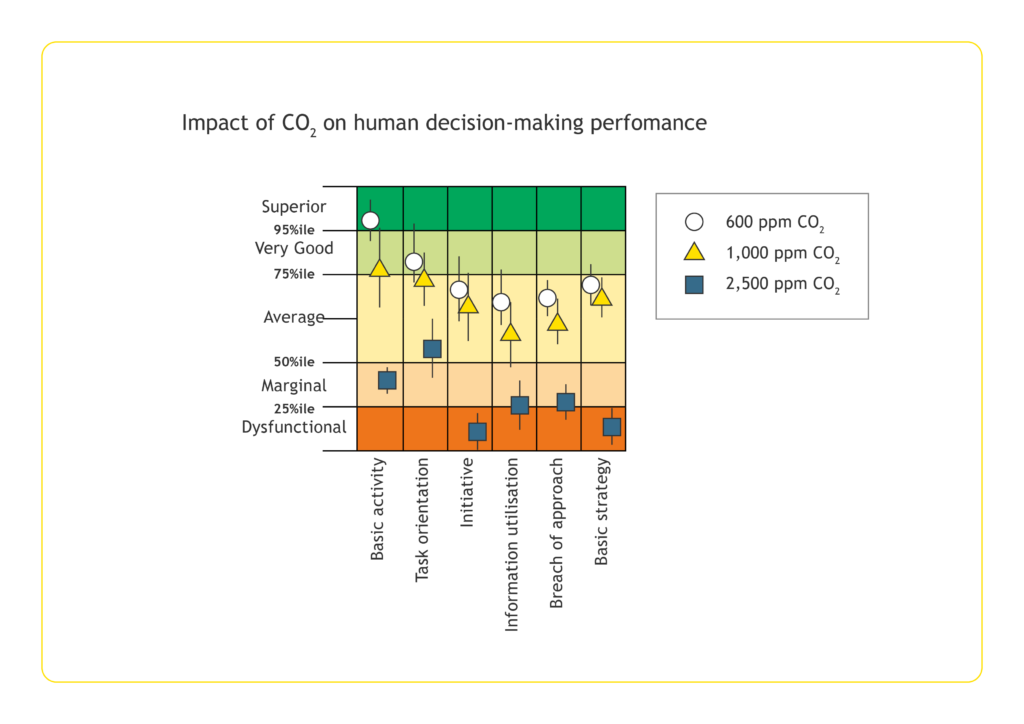The knowledge of air pollutants such as nitrogen oxides and its impacts on our health are well known and researched. What we haven’t heard much about is the affect of indoor Carbon Dioxide (CO2) on our health. From sluggish two o’clock meetings to poor sleep, elevated concentrations of indoor CO2 can influence our well-being in a number of unexpected ways.
What is CO2 and where it comes from
CO2 is one of the most important gases on earth, because life depends upon it. Without CO2, the basis for the synthesis of carbohydrates, proteins and fats would not occur. This means that without CO2, plants and animals would not have food or nutrients to survive.
CO2 is a non-visible gas that is made up of one carbon atom and two oxygen atoms. It arises from multiple natural sources including volcanoes, the combustion of organic matter, and as a waste by-product of respiration. CO2 is what we expel into the air every time we breath.
CO2 in the atmosphere is maintained through a natural balancing cycle. Here it is continually exchanged between the atmosphere, plants and animals through photosynthesis, respiration, and decomposition, and between the atmosphere and ocean through gas exchange. Whilst CO2 is not poisonous, in excess, it is now known to have negative impacts on our health and cognitive performance.
The natural balance of CO2 on our planet has been disrupted through increased man-made CO2. Too much CO2 in the atmosphere from excessive combustion of fossil fuels and other carbon-based fuels, like timber, cars and industry, creates a heating affect called global warming. Today the negative impacts of this warming have sadly been seen and felt globally.


What About Excess CO2 In Our Homes and Work Environments
Interestingly, today, our houses are more air-tight and energy efficient than ever. While this is good for our wallet and warmth, it does also mean they have less fresh air flowing through. Given that we spend much of our time indoors, it is surprising that internal air quality has not faced more scrutiny. The good news is the government launched the clean air strategy in 2019 and raising awareness of internal air quality is part of their clean air plans. To start with, it is good to know a bit more about the effects of indoor CO2 build up, where it comes from and what you can do to improve the quality of the air you breath inside.
In terms of CO2 in our homes or enclosed work environments, the higher the CO2 value in a building, the less comfortable it becomes for the people inside. In poorly ventilated rooms, the CO2 concentration does rise rapidly as it arises from respiration. For example, in a space of about 4 m2 occupied by only one person, the CO2 value rises from 500 ppm (0.05%) to more than 1,000 ppm (0.1%) in just 45 minutes. At this level, CO2 can cause headaches, drowsiness, and poor concentration, often resulting in reduced productivity. From 2,000 ppm onward (0.2%), our cognitive abilities can be influenced, and higher levels than this, there is a significant risk to health (Figure 1)

Figure 1: CO2 matters because levels of above 2,000 ppm significantly impact cognitive function.
Research has even shown that increase levels of CO2 has been related to weight gain.
Where does internal CO2 come from?
Respiration is actually the most significant source of indoor carbon dioxide as our bodies use oxygen and make carbon dioxide. So, the air you exhale has a much higher concentration of CO2 than the surrounding air. Mixed with the air already in a closed room, the overall CO2 levels will increase further over time.
In a room where there are lots of people, this process increases even further. Places like classrooms and office meeting rooms are very susceptible to higher concentrations of CO2.
Your Kitchen and fireplace

Any open flame from your cooker, fireplace or even a candle will produce extra CO2. Flames consume oxygen which add to the amount of CO2 in the building.
Cigarettes

Alongside other harmful particles, cigarettes reduce oxygen in the air through their combustion as tobacco and paper are carbon based. Needless to stay, cigarettes not only affect our cognitive performance but also damage our lungs and organ health.
How to stop CO2 build up
Ventilation and Air Purification
With all these sources of CO2, making sure you have good ventilation in a room is critical to maintaining good air quality in your home and work environment. Opening windows and doors as well as making sure your ventilation or purification system is working will help to keep the levels of CO2 down, maintaining your health and cognitive performance.
Ban Smoking Indoors
The negative effects of smoking and its impact on internal air quality and health means smoking indoors really should be a no-no.
No long face-to-face meetings
Now isn’t that a sound for sore ears. Keeping office rooms well ventilated and length of meetings to a time limit will keep everyone performing at the top of their game.
Hope you found this article helpful and informative. Please feel free to share
